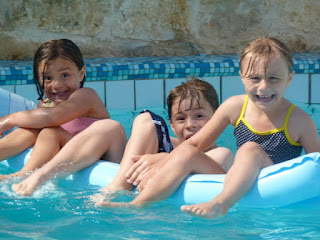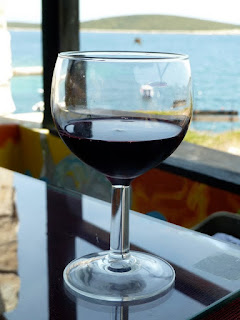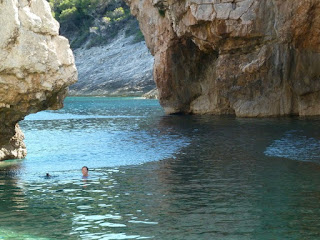 |
| Vis, Croatia |
The Dalmatian island Vis is located 2 ½ hours by ferry from the mainland; it’s one of the furthest offshore inhabited islands in the Adriatic. Between WWII and 1989, Vis was essentially closed to foreigners for military/strategic reasons; so much of the infrastructure today is still not polished and tourist-friendly. Even the GPS regularly tells you to turn off a cliff. Because it’s so isolated, the island is unspoiled and free of the throngs of cruise boat tourists. Croatians love Vis for these reasons, plus its fascinating history (including a short period of British rule), the wild mountains, gorgeous beaches, the orchards and vineyards (the grapes on Vis have been famous for over 2000 years), the fish, the pristine beaches, and the two charming villages, one of which was originally a Greek settlement.
 |
| The treacherous street we drove through |
The ferry ride was expensive but uneventful, which was good, because we ended up having enough of an event on the way to the guesthouse/hotel. As I hinted, don’t count on your GPS in Vis. When the roads were laid out, perhaps when the island was a Greek colony, some points in the road were only 1.89 meters wide, and they are still that width today. There are stone buildings on each side of the road, so 1.89 meters doesn’t mean 1.89 meters with a small shoulder or grassy patch turnaround areas with which you can buffer a tight squeeze. It means that you car better not be 1.90 meters wide, and god forbid, if you need to turn around, you better be skilled in driving in reverse with no more than an inch leeway on either side of your tucked-in side view mirrors. We were on this road for at least a couple kilometers in this fashion, white-knuckled, and yelling at the kids to be quiet so we could concentrate.
But then we approached a narrowing in the road that seemed to me, absolutely impossible to pass. We faced getting out of this mess by repeating the whole process in stick shift reverse, virtually guaranteeing major damage to the car, or going by foot to get our hotel owner, who could hopefully provide us with some guidance. We decided on the latter, so I headed to our hotel in the burning hot midday son, leaving Adam and the entire family in the car, and found the hotel about another kilometer up the road. Our hotel owner, Vojko (pronounced Voy-ko), a true Mediterranean man, immediately put me at ease, said that this happens all the time, and walked with me back to the bottleneck.
In the meanwhile, Adam’s guardian angel had appeared out of nowhere and guided him through that treacherous spot, and the next treacherous spot, until the road widened to the point where she told him “Now you are free!”. While Vojko and I were wondering where the car was, Adam and the kids appeared. Adam told us about the helpful mystery lady and then we all walked up the road to where Adam parked, got in the car, including Vojko and his toy poodle, and drove to the house. Vojko showed us the gravel road above the house that was the correct way to arrive. Unfortunately, we noticed some scratches on the car, so when we get back to Rijeka, we will probably get to test that little car insurance proviso when you rent a car using your credit card.
 |
| Bonus! A pool at the house |
It goes without saying that we walked to dinner that night. We strolled down the same pathway our little car was squeezing through earlier in the day, to a restaurant Vojko recommended called Pajode. We sat in an outdoor courtyard edged with huge rosemary bushes. The kids had fresh squeezed lemonade under a lemon tree, and before our meal arrived, our waiter was up in that lemon tree harvesting a bag of lemons. We had two kinds of fish for dinner, a grilled white fish similar to orada, and a red scorpion fish which Jonah picked out, prepared in a traditional way called buzzara.
 |
| Liquid sunshine from La Terrazze |
The next day, we let the kids swim in the pool before packing up the beach gear. Then we headed for the beaches on the southeastern part of the island. Vojko highlighted on a map several fabulous beaches on the island, but in Vis, knowing where you are trying to go with a map has little to do with actually getting there. It took us a long time to find a beach, but we eventually made it to Teplus , a quite deserted, rocky beach with just a couple buildings in sight, including the restaurant La Terrazza, where we had lunch. We ordered a delicious local red called Plavac (a bottle of which Vojko had given to us, from his own grapes), a mixed green salad, and a popular spicy grilled sausage called civape. It was really perfect, all the moreso because we were starving to death. The next beach, Srbrena (meaning silver beach) was far more populated, and it has an FKK beach discreetly off to the side (one of many in Croatia, as the result of 1960s tourism market research which suggested that the northern Europeans would be more likely to visit Croatia if there were nude beaches).
 |
| On silver beach |
The day was incredibly windy, and we leaned that it was due to a southerly wind called the yugo (as in Yugoslavia, which means south slavs). The winds made for some powerful waves so we had to be a little more cautious at this beach. When the kids were tired out, we packed up the beach gear and drove to the most western part of the island to the second largest village, a fishing hamlet, called Komiza (just 10 or 18km away, depending on whether you take the scenic mountain route or the scenic coastal route). The approach to the village was spectacular. We walked around the village for a little bit and got a bite for dinner and picked up some items for breakfast before heading back.
 |
| Hiking to Tito's Hideout |
 |
| Tito's Cave on Mt. Hum, Vis, Croatia |
The next day, we let the kids swim in the pool before heading back to Kozima for a boat trip to the island of Bisevo, to see the famous “blue grotto.” We initially thought we had had arrived too late and we had missed all the excursions to the island, but as we later learned, no boats were going because of the yugo. The yugo had driven up the tide, and since entrance to the cave is just under 2m high (6’ 6”), it was too dangerous for boats to enter the cave. So Adam organized a tour of the cave for the next morning, our last morning on the island, and we left Kozima for Rucavac, where there were boats for hire with which we hoped to salvage the day. On the way to Rucavac, we drove and then hiked a little further up Mount Hum, the tallest mountain on the island, into a couple caves, where Tito and the partisans hid out from the Nazis during WWII and held secret meetings with the Allies.
When we finally got to Rucavac, Adam called the first phone number on a boat-for-hire poster we saw, and we found ourselves on a little blue boat with Captain Antonio within 15 minutes. We had a couple hours of the boat rental, so we asked him to take us to the green grotto cave, then to a very remote pebbly beach in a cove called Stiniva, accessible by boat or by an hour long goat path hike down a canyon.
 |
| The Green Grotto |
Antonio first boated us to the “green grotto”. Essentially, there was a little hole in the ceiling of the cave which illuminated a spot in the water. In the cave, Adam and the girls climbed off the boat and swam into the green light. They got back on the boat and we boated to Stiniva beach. Antonio got us through a 4-5 meter wide break in massive limestone cliffs , and once we passed through, the rock walls spread out and enclosed a 30 meter wide clean and practically deserted beach. We all swam there, and soaked up the impossibly clear water in this stunningly beautiful cove, and after Lubenice, we all felt very spoiled to have navigated to the beach by boat instead of by Keen.
 |
| Our rental boat on Stiniva Beach |
 |
| Stiniva Beach, Vis, Croatia |
On the way back to Vis town, we had dinner at Roki’s, which we later learned is sort of an institution on the island, although you would never know it by the signage or the astro-turf covered Ford parked alongside the rusted tractors in the parking lot (most tourists come by taxi van). It was an odd collection of stone buildings, a vineyard (it was a winery also), a cricket field (the sport leftover from Vis’ days as a British colony), outdoor tables placed all over, and a peka shed. Peka refers to a traditional sort of food preparation: either meat or shellfish (fish is too delicate) are placed in an enamel bowl inside a cast iron pod with a lid. Then burning hot coals are placed above and below the pot and the food is left to cook in that manner for up to three hours. Since octopus only takes 90 minutes, and we hadn’t preordered the meal, octopus it was. It was a large octopus, and while it tasted like fish, the texture was more like gummy bears with a layer of fat and little round suckers. It wasn’t my favorite meal, but I loved looking at it. Adam and I went through a whole bottle of their 2007 Plavac – our favorite from the wine tasting that kicked off our meal. The kids roamed the property, collected a huge bag of fennel (which is a weed here), played with the dog, and wandered around the grapevines while we relaxed.
After we got back to the guesthouse, Adam and Georgie went for a swim. When I was going back into our apartment, I walked straight into the glass door and broke right through the glass. I was uninjured, but mortified! But my good Mediterannean landlord took it with grace and only charged us about $80 for the replacement glass (which has to be ordered from Split since there are no glass stores on the island).
 |
| Peka |
The next morning we went back to Komiza and boarded a boat to the blue grotto on Bisevo island. Adam and I had seen a similar natural phenomenon in Capri. The kids loved the speedboat ride, but when we got to the ticket stand to buy tickets to board another smaller boat that can make it through the mouth of the cave, it was a sweltering, disorganized mob scene. After 40 minutes of waiting in a “line” that went nowhere, our boat driver had us reboard the original boat, and he took us to the entrance of the cave where there was a boat waiting. We boarded that boat, did the blue grotto circuit with several other boats, and the kids were suitably impressed.
 |
| Yep. |
We reluctantly headed back to Vis to catch the 2 ½ hour ferry back to the mainland for the last leg of our trip. I say reluctantly, because we wished we had scheduled at least a week on the island. After we found out that our room on Vis was still available, we very nearly cancelled our Dubrovnik hotel, but in the end, the lure of the “pearl of the Adriatic” was too strong and we headed to the ferry. If we ever find ourselves back in Dalmatia, we will be revisit Vis, and next time, it will be for more than three days.
 |
| Scorpion on the sidewalk |
 |
| In the Blue Grotto |
